BCO5501 - Business Process Engineering: BPM Review and Analysis
VerifiedAdded on 2023/03/30
|8
|2387
|319
Report
AI Summary
This report is a review of the article "Rethinking BPM in a Cognitive World: Transforming How We Learn and Perform Business Processes" by Hull and Nezhad (2016). The author explores the impact of cognitive computing, driven by advancements in NLP, AI, and machine learning, on business process management. The review highlights the transformation of BPM through knowledge acquisition, a new "Plan Act Learn" meta-model, and process learning from implicit descriptions. The report provides an overview of cognitive computing, its framework, and its four pillars: cognitive decision support, interaction, learning, and process enablement. It discusses the cognitive BPM framework and the abstraction levels relevant to cognitively enabled processes, including important building blocks and the Plan Act Learn cycle. The review also covers cognitive learning of business processes and cognitive process enablement, concluding with the research challenges and key areas in cognitive business process management. The report supports the review with additional relevant articles and adheres to Harvard style citations.

Running head: BUSINESS PROCESS ENGINEERING
Business Process Engineering
Name of the Student
Name of the University
Author Note
Business Process Engineering
Name of the Student
Name of the University
Author Note
Paraphrase This Document
Need a fresh take? Get an instant paraphrase of this document with our AI Paraphraser
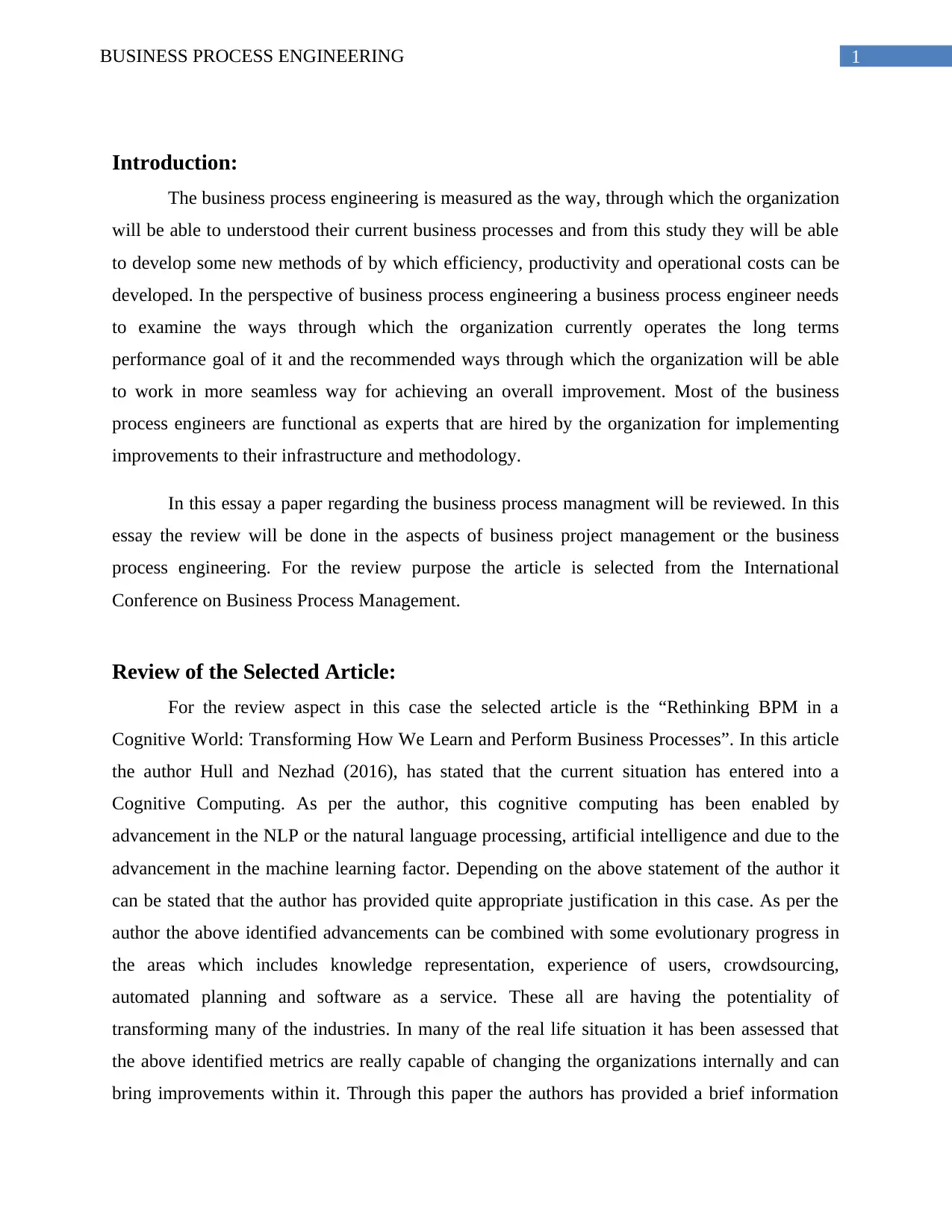
1BUSINESS PROCESS ENGINEERING
Introduction:
The business process engineering is measured as the way, through which the organization
will be able to understood their current business processes and from this study they will be able
to develop some new methods of by which efficiency, productivity and operational costs can be
developed. In the perspective of business process engineering a business process engineer needs
to examine the ways through which the organization currently operates the long terms
performance goal of it and the recommended ways through which the organization will be able
to work in more seamless way for achieving an overall improvement. Most of the business
process engineers are functional as experts that are hired by the organization for implementing
improvements to their infrastructure and methodology.
In this essay a paper regarding the business process managment will be reviewed. In this
essay the review will be done in the aspects of business project management or the business
process engineering. For the review purpose the article is selected from the International
Conference on Business Process Management.
Review of the Selected Article:
For the review aspect in this case the selected article is the “Rethinking BPM in a
Cognitive World: Transforming How We Learn and Perform Business Processes”. In this article
the author Hull and Nezhad (2016), has stated that the current situation has entered into a
Cognitive Computing. As per the author, this cognitive computing has been enabled by
advancement in the NLP or the natural language processing, artificial intelligence and due to the
advancement in the machine learning factor. Depending on the above statement of the author it
can be stated that the author has provided quite appropriate justification in this case. As per the
author the above identified advancements can be combined with some evolutionary progress in
the areas which includes knowledge representation, experience of users, crowdsourcing,
automated planning and software as a service. These all are having the potentiality of
transforming many of the industries. In many of the real life situation it has been assessed that
the above identified metrics are really capable of changing the organizations internally and can
bring improvements within it. Through this paper the authors has provided a brief information
Introduction:
The business process engineering is measured as the way, through which the organization
will be able to understood their current business processes and from this study they will be able
to develop some new methods of by which efficiency, productivity and operational costs can be
developed. In the perspective of business process engineering a business process engineer needs
to examine the ways through which the organization currently operates the long terms
performance goal of it and the recommended ways through which the organization will be able
to work in more seamless way for achieving an overall improvement. Most of the business
process engineers are functional as experts that are hired by the organization for implementing
improvements to their infrastructure and methodology.
In this essay a paper regarding the business process managment will be reviewed. In this
essay the review will be done in the aspects of business project management or the business
process engineering. For the review purpose the article is selected from the International
Conference on Business Process Management.
Review of the Selected Article:
For the review aspect in this case the selected article is the “Rethinking BPM in a
Cognitive World: Transforming How We Learn and Perform Business Processes”. In this article
the author Hull and Nezhad (2016), has stated that the current situation has entered into a
Cognitive Computing. As per the author, this cognitive computing has been enabled by
advancement in the NLP or the natural language processing, artificial intelligence and due to the
advancement in the machine learning factor. Depending on the above statement of the author it
can be stated that the author has provided quite appropriate justification in this case. As per the
author the above identified advancements can be combined with some evolutionary progress in
the areas which includes knowledge representation, experience of users, crowdsourcing,
automated planning and software as a service. These all are having the potentiality of
transforming many of the industries. In many of the real life situation it has been assessed that
the above identified metrics are really capable of changing the organizations internally and can
bring improvements within it. Through this paper the authors has provided a brief information
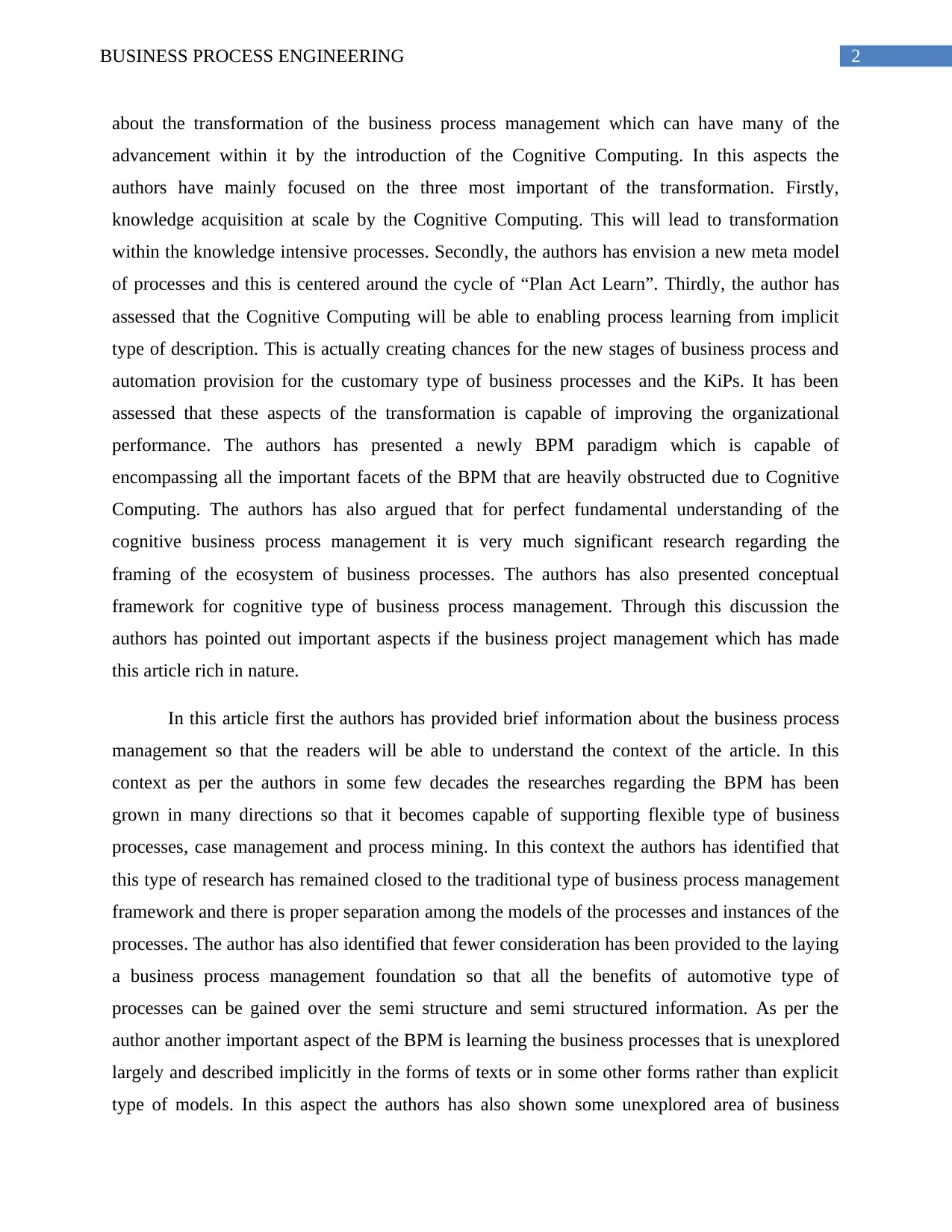
2BUSINESS PROCESS ENGINEERING
about the transformation of the business process management which can have many of the
advancement within it by the introduction of the Cognitive Computing. In this aspects the
authors have mainly focused on the three most important of the transformation. Firstly,
knowledge acquisition at scale by the Cognitive Computing. This will lead to transformation
within the knowledge intensive processes. Secondly, the authors has envision a new meta model
of processes and this is centered around the cycle of “Plan Act Learn”. Thirdly, the author has
assessed that the Cognitive Computing will be able to enabling process learning from implicit
type of description. This is actually creating chances for the new stages of business process and
automation provision for the customary type of business processes and the KiPs. It has been
assessed that these aspects of the transformation is capable of improving the organizational
performance. The authors has presented a newly BPM paradigm which is capable of
encompassing all the important facets of the BPM that are heavily obstructed due to Cognitive
Computing. The authors has also argued that for perfect fundamental understanding of the
cognitive business process management it is very much significant research regarding the
framing of the ecosystem of business processes. The authors has also presented conceptual
framework for cognitive type of business process management. Through this discussion the
authors has pointed out important aspects if the business project management which has made
this article rich in nature.
In this article first the authors has provided brief information about the business process
management so that the readers will be able to understand the context of the article. In this
context as per the authors in some few decades the researches regarding the BPM has been
grown in many directions so that it becomes capable of supporting flexible type of business
processes, case management and process mining. In this context the authors has identified that
this type of research has remained closed to the traditional type of business process management
framework and there is proper separation among the models of the processes and instances of the
processes. The author has also identified that fewer consideration has been provided to the laying
a business process management foundation so that all the benefits of automotive type of
processes can be gained over the semi structure and semi structured information. As per the
author another important aspect of the BPM is learning the business processes that is unexplored
largely and described implicitly in the forms of texts or in some other forms rather than explicit
type of models. In this aspect the authors has also shown some unexplored area of business
about the transformation of the business process management which can have many of the
advancement within it by the introduction of the Cognitive Computing. In this aspects the
authors have mainly focused on the three most important of the transformation. Firstly,
knowledge acquisition at scale by the Cognitive Computing. This will lead to transformation
within the knowledge intensive processes. Secondly, the authors has envision a new meta model
of processes and this is centered around the cycle of “Plan Act Learn”. Thirdly, the author has
assessed that the Cognitive Computing will be able to enabling process learning from implicit
type of description. This is actually creating chances for the new stages of business process and
automation provision for the customary type of business processes and the KiPs. It has been
assessed that these aspects of the transformation is capable of improving the organizational
performance. The authors has presented a newly BPM paradigm which is capable of
encompassing all the important facets of the BPM that are heavily obstructed due to Cognitive
Computing. The authors has also argued that for perfect fundamental understanding of the
cognitive business process management it is very much significant research regarding the
framing of the ecosystem of business processes. The authors has also presented conceptual
framework for cognitive type of business process management. Through this discussion the
authors has pointed out important aspects if the business project management which has made
this article rich in nature.
In this article first the authors has provided brief information about the business process
management so that the readers will be able to understand the context of the article. In this
context as per the authors in some few decades the researches regarding the BPM has been
grown in many directions so that it becomes capable of supporting flexible type of business
processes, case management and process mining. In this context the authors has identified that
this type of research has remained closed to the traditional type of business process management
framework and there is proper separation among the models of the processes and instances of the
processes. The author has also identified that fewer consideration has been provided to the laying
a business process management foundation so that all the benefits of automotive type of
processes can be gained over the semi structure and semi structured information. As per the
author another important aspect of the BPM is learning the business processes that is unexplored
largely and described implicitly in the forms of texts or in some other forms rather than explicit
type of models. In this aspect the authors has also shown some unexplored area of business
⊘ This is a preview!⊘
Do you want full access?
Subscribe today to unlock all pages.

Trusted by 1+ million students worldwide
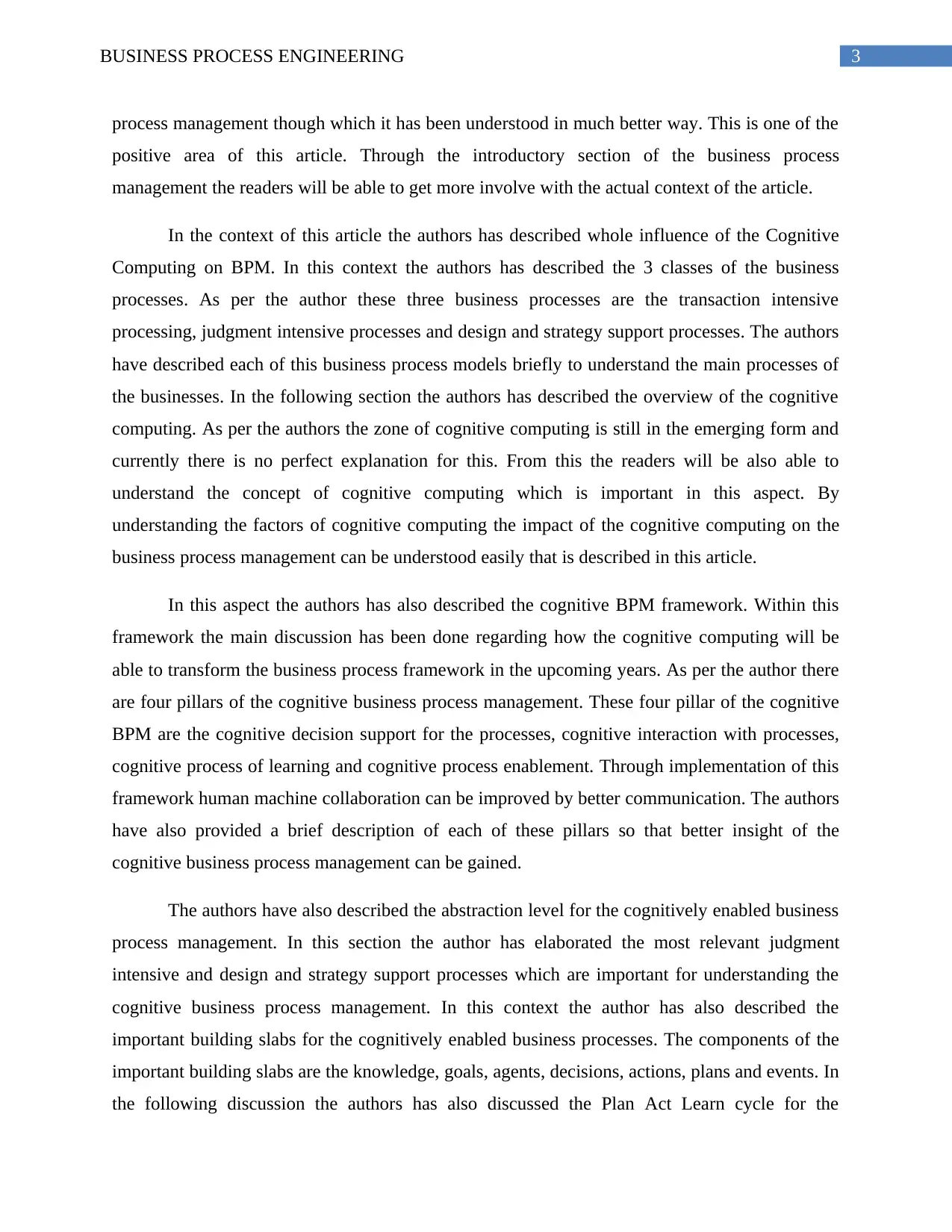
3BUSINESS PROCESS ENGINEERING
process management though which it has been understood in much better way. This is one of the
positive area of this article. Through the introductory section of the business process
management the readers will be able to get more involve with the actual context of the article.
In the context of this article the authors has described whole influence of the Cognitive
Computing on BPM. In this context the authors has described the 3 classes of the business
processes. As per the author these three business processes are the transaction intensive
processing, judgment intensive processes and design and strategy support processes. The authors
have described each of this business process models briefly to understand the main processes of
the businesses. In the following section the authors has described the overview of the cognitive
computing. As per the authors the zone of cognitive computing is still in the emerging form and
currently there is no perfect explanation for this. From this the readers will be also able to
understand the concept of cognitive computing which is important in this aspect. By
understanding the factors of cognitive computing the impact of the cognitive computing on the
business process management can be understood easily that is described in this article.
In this aspect the authors has also described the cognitive BPM framework. Within this
framework the main discussion has been done regarding how the cognitive computing will be
able to transform the business process framework in the upcoming years. As per the author there
are four pillars of the cognitive business process management. These four pillar of the cognitive
BPM are the cognitive decision support for the processes, cognitive interaction with processes,
cognitive process of learning and cognitive process enablement. Through implementation of this
framework human machine collaboration can be improved by better communication. The authors
have also provided a brief description of each of these pillars so that better insight of the
cognitive business process management can be gained.
The authors have also described the abstraction level for the cognitively enabled business
process management. In this section the author has elaborated the most relevant judgment
intensive and design and strategy support processes which are important for understanding the
cognitive business process management. In this context the author has also described the
important building slabs for the cognitively enabled business processes. The components of the
important building slabs are the knowledge, goals, agents, decisions, actions, plans and events. In
the following discussion the authors has also discussed the Plan Act Learn cycle for the
process management though which it has been understood in much better way. This is one of the
positive area of this article. Through the introductory section of the business process
management the readers will be able to get more involve with the actual context of the article.
In the context of this article the authors has described whole influence of the Cognitive
Computing on BPM. In this context the authors has described the 3 classes of the business
processes. As per the author these three business processes are the transaction intensive
processing, judgment intensive processes and design and strategy support processes. The authors
have described each of this business process models briefly to understand the main processes of
the businesses. In the following section the authors has described the overview of the cognitive
computing. As per the authors the zone of cognitive computing is still in the emerging form and
currently there is no perfect explanation for this. From this the readers will be also able to
understand the concept of cognitive computing which is important in this aspect. By
understanding the factors of cognitive computing the impact of the cognitive computing on the
business process management can be understood easily that is described in this article.
In this aspect the authors has also described the cognitive BPM framework. Within this
framework the main discussion has been done regarding how the cognitive computing will be
able to transform the business process framework in the upcoming years. As per the author there
are four pillars of the cognitive business process management. These four pillar of the cognitive
BPM are the cognitive decision support for the processes, cognitive interaction with processes,
cognitive process of learning and cognitive process enablement. Through implementation of this
framework human machine collaboration can be improved by better communication. The authors
have also provided a brief description of each of these pillars so that better insight of the
cognitive business process management can be gained.
The authors have also described the abstraction level for the cognitively enabled business
process management. In this section the author has elaborated the most relevant judgment
intensive and design and strategy support processes which are important for understanding the
cognitive business process management. In this context the author has also described the
important building slabs for the cognitively enabled business processes. The components of the
important building slabs are the knowledge, goals, agents, decisions, actions, plans and events. In
the following discussion the authors has also discussed the Plan Act Learn cycle for the
Paraphrase This Document
Need a fresh take? Get an instant paraphrase of this document with our AI Paraphraser
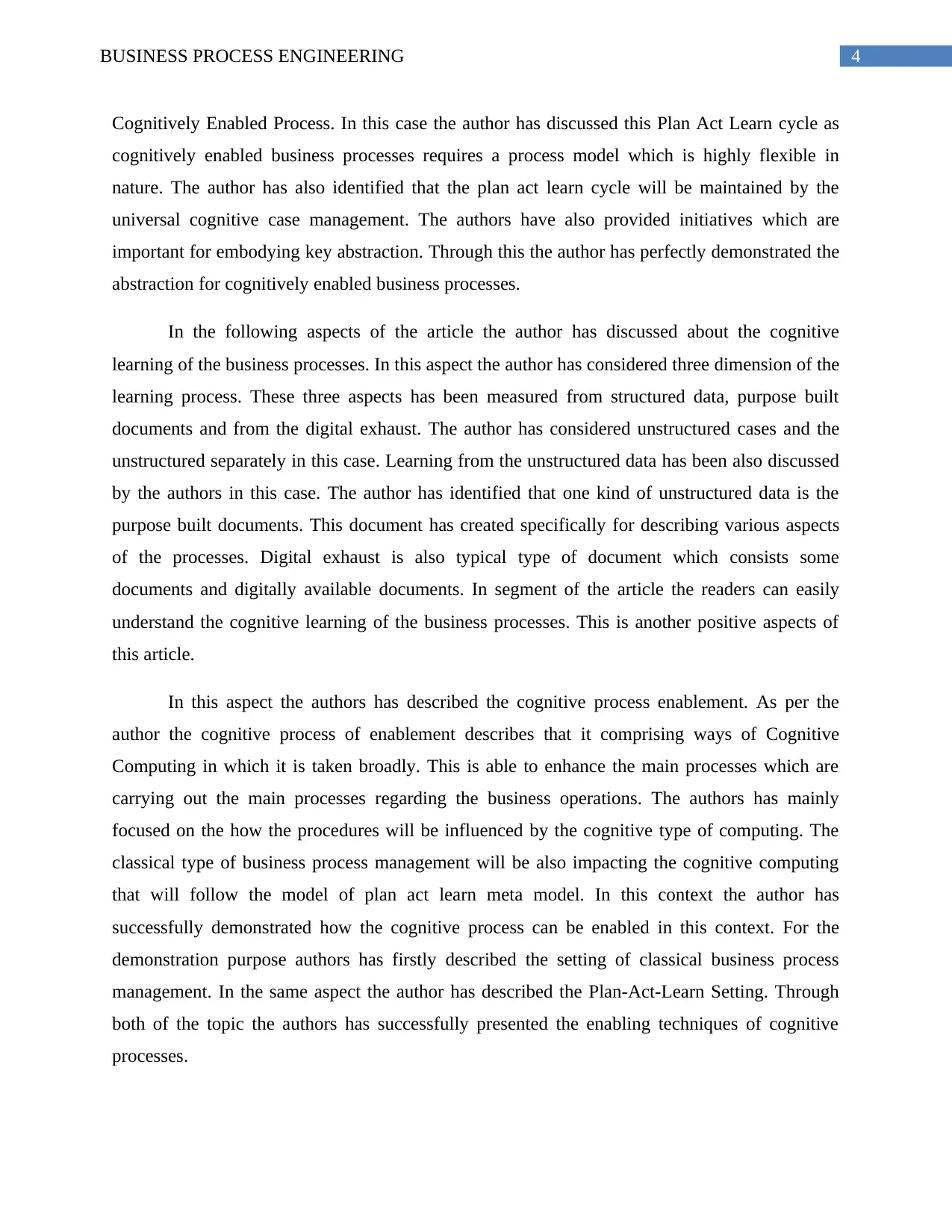
4BUSINESS PROCESS ENGINEERING
Cognitively Enabled Process. In this case the author has discussed this Plan Act Learn cycle as
cognitively enabled business processes requires a process model which is highly flexible in
nature. The author has also identified that the plan act learn cycle will be maintained by the
universal cognitive case management. The authors have also provided initiatives which are
important for embodying key abstraction. Through this the author has perfectly demonstrated the
abstraction for cognitively enabled business processes.
In the following aspects of the article the author has discussed about the cognitive
learning of the business processes. In this aspect the author has considered three dimension of the
learning process. These three aspects has been measured from structured data, purpose built
documents and from the digital exhaust. The author has considered unstructured cases and the
unstructured separately in this case. Learning from the unstructured data has been also discussed
by the authors in this case. The author has identified that one kind of unstructured data is the
purpose built documents. This document has created specifically for describing various aspects
of the processes. Digital exhaust is also typical type of document which consists some
documents and digitally available documents. In segment of the article the readers can easily
understand the cognitive learning of the business processes. This is another positive aspects of
this article.
In this aspect the authors has described the cognitive process enablement. As per the
author the cognitive process of enablement describes that it comprising ways of Cognitive
Computing in which it is taken broadly. This is able to enhance the main processes which are
carrying out the main processes regarding the business operations. The authors has mainly
focused on the how the procedures will be influenced by the cognitive type of computing. The
classical type of business process management will be also impacting the cognitive computing
that will follow the model of plan act learn meta model. In this context the author has
successfully demonstrated how the cognitive process can be enabled in this context. For the
demonstration purpose authors has firstly described the setting of classical business process
management. In the same aspect the author has described the Plan-Act-Learn Setting. Through
both of the topic the authors has successfully presented the enabling techniques of cognitive
processes.
Cognitively Enabled Process. In this case the author has discussed this Plan Act Learn cycle as
cognitively enabled business processes requires a process model which is highly flexible in
nature. The author has also identified that the plan act learn cycle will be maintained by the
universal cognitive case management. The authors have also provided initiatives which are
important for embodying key abstraction. Through this the author has perfectly demonstrated the
abstraction for cognitively enabled business processes.
In the following aspects of the article the author has discussed about the cognitive
learning of the business processes. In this aspect the author has considered three dimension of the
learning process. These three aspects has been measured from structured data, purpose built
documents and from the digital exhaust. The author has considered unstructured cases and the
unstructured separately in this case. Learning from the unstructured data has been also discussed
by the authors in this case. The author has identified that one kind of unstructured data is the
purpose built documents. This document has created specifically for describing various aspects
of the processes. Digital exhaust is also typical type of document which consists some
documents and digitally available documents. In segment of the article the readers can easily
understand the cognitive learning of the business processes. This is another positive aspects of
this article.
In this aspect the authors has described the cognitive process enablement. As per the
author the cognitive process of enablement describes that it comprising ways of Cognitive
Computing in which it is taken broadly. This is able to enhance the main processes which are
carrying out the main processes regarding the business operations. The authors has mainly
focused on the how the procedures will be influenced by the cognitive type of computing. The
classical type of business process management will be also impacting the cognitive computing
that will follow the model of plan act learn meta model. In this context the author has
successfully demonstrated how the cognitive process can be enabled in this context. For the
demonstration purpose authors has firstly described the setting of classical business process
management. In the same aspect the author has described the Plan-Act-Learn Setting. Through
both of the topic the authors has successfully presented the enabling techniques of cognitive
processes.
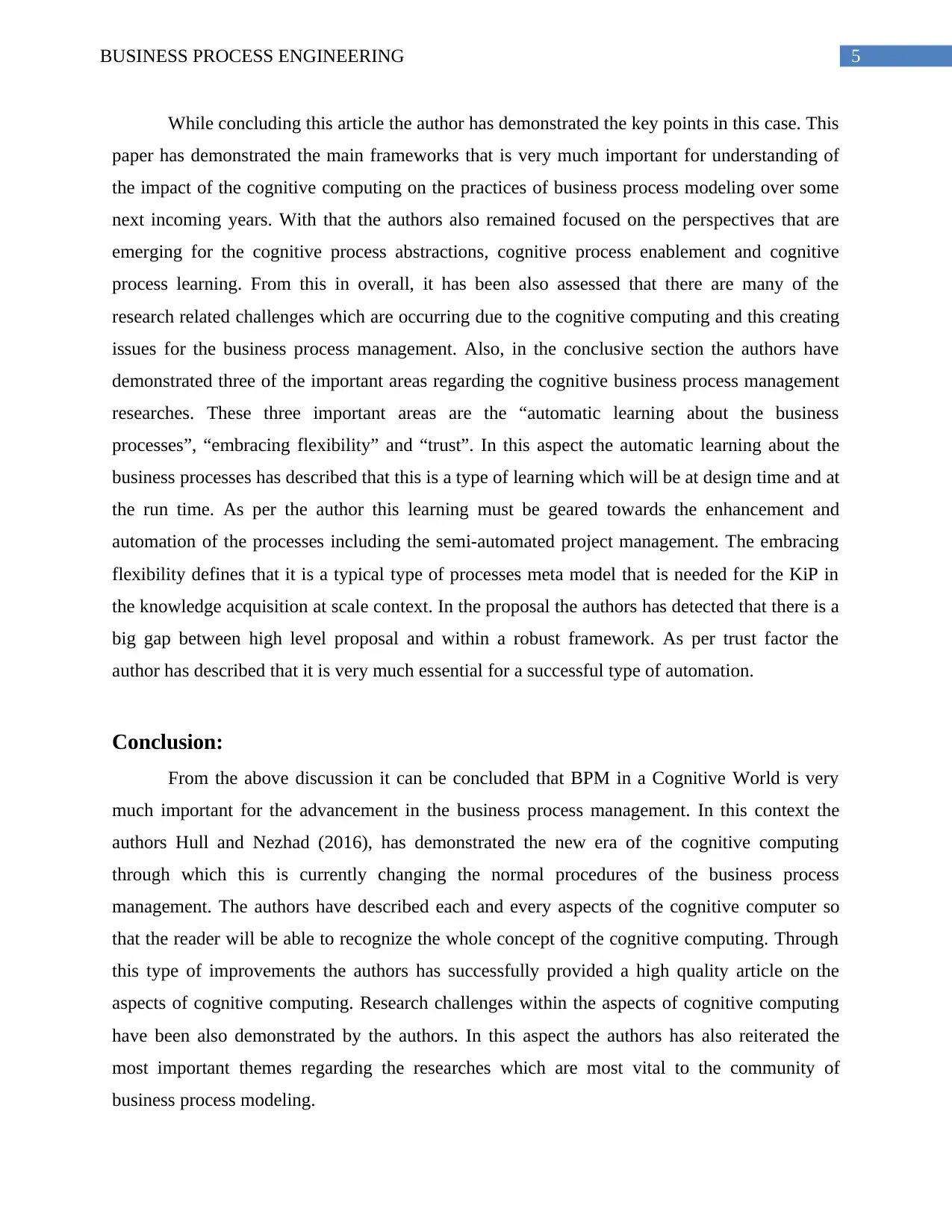
5BUSINESS PROCESS ENGINEERING
While concluding this article the author has demonstrated the key points in this case. This
paper has demonstrated the main frameworks that is very much important for understanding of
the impact of the cognitive computing on the practices of business process modeling over some
next incoming years. With that the authors also remained focused on the perspectives that are
emerging for the cognitive process abstractions, cognitive process enablement and cognitive
process learning. From this in overall, it has been also assessed that there are many of the
research related challenges which are occurring due to the cognitive computing and this creating
issues for the business process management. Also, in the conclusive section the authors have
demonstrated three of the important areas regarding the cognitive business process management
researches. These three important areas are the “automatic learning about the business
processes”, “embracing flexibility” and “trust”. In this aspect the automatic learning about the
business processes has described that this is a type of learning which will be at design time and at
the run time. As per the author this learning must be geared towards the enhancement and
automation of the processes including the semi-automated project management. The embracing
flexibility defines that it is a typical type of processes meta model that is needed for the KiP in
the knowledge acquisition at scale context. In the proposal the authors has detected that there is a
big gap between high level proposal and within a robust framework. As per trust factor the
author has described that it is very much essential for a successful type of automation.
Conclusion:
From the above discussion it can be concluded that BPM in a Cognitive World is very
much important for the advancement in the business process management. In this context the
authors Hull and Nezhad (2016), has demonstrated the new era of the cognitive computing
through which this is currently changing the normal procedures of the business process
management. The authors have described each and every aspects of the cognitive computer so
that the reader will be able to recognize the whole concept of the cognitive computing. Through
this type of improvements the authors has successfully provided a high quality article on the
aspects of cognitive computing. Research challenges within the aspects of cognitive computing
have been also demonstrated by the authors. In this aspect the authors has also reiterated the
most important themes regarding the researches which are most vital to the community of
business process modeling.
While concluding this article the author has demonstrated the key points in this case. This
paper has demonstrated the main frameworks that is very much important for understanding of
the impact of the cognitive computing on the practices of business process modeling over some
next incoming years. With that the authors also remained focused on the perspectives that are
emerging for the cognitive process abstractions, cognitive process enablement and cognitive
process learning. From this in overall, it has been also assessed that there are many of the
research related challenges which are occurring due to the cognitive computing and this creating
issues for the business process management. Also, in the conclusive section the authors have
demonstrated three of the important areas regarding the cognitive business process management
researches. These three important areas are the “automatic learning about the business
processes”, “embracing flexibility” and “trust”. In this aspect the automatic learning about the
business processes has described that this is a type of learning which will be at design time and at
the run time. As per the author this learning must be geared towards the enhancement and
automation of the processes including the semi-automated project management. The embracing
flexibility defines that it is a typical type of processes meta model that is needed for the KiP in
the knowledge acquisition at scale context. In the proposal the authors has detected that there is a
big gap between high level proposal and within a robust framework. As per trust factor the
author has described that it is very much essential for a successful type of automation.
Conclusion:
From the above discussion it can be concluded that BPM in a Cognitive World is very
much important for the advancement in the business process management. In this context the
authors Hull and Nezhad (2016), has demonstrated the new era of the cognitive computing
through which this is currently changing the normal procedures of the business process
management. The authors have described each and every aspects of the cognitive computer so
that the reader will be able to recognize the whole concept of the cognitive computing. Through
this type of improvements the authors has successfully provided a high quality article on the
aspects of cognitive computing. Research challenges within the aspects of cognitive computing
have been also demonstrated by the authors. In this aspect the authors has also reiterated the
most important themes regarding the researches which are most vital to the community of
business process modeling.
⊘ This is a preview!⊘
Do you want full access?
Subscribe today to unlock all pages.

Trusted by 1+ million students worldwide
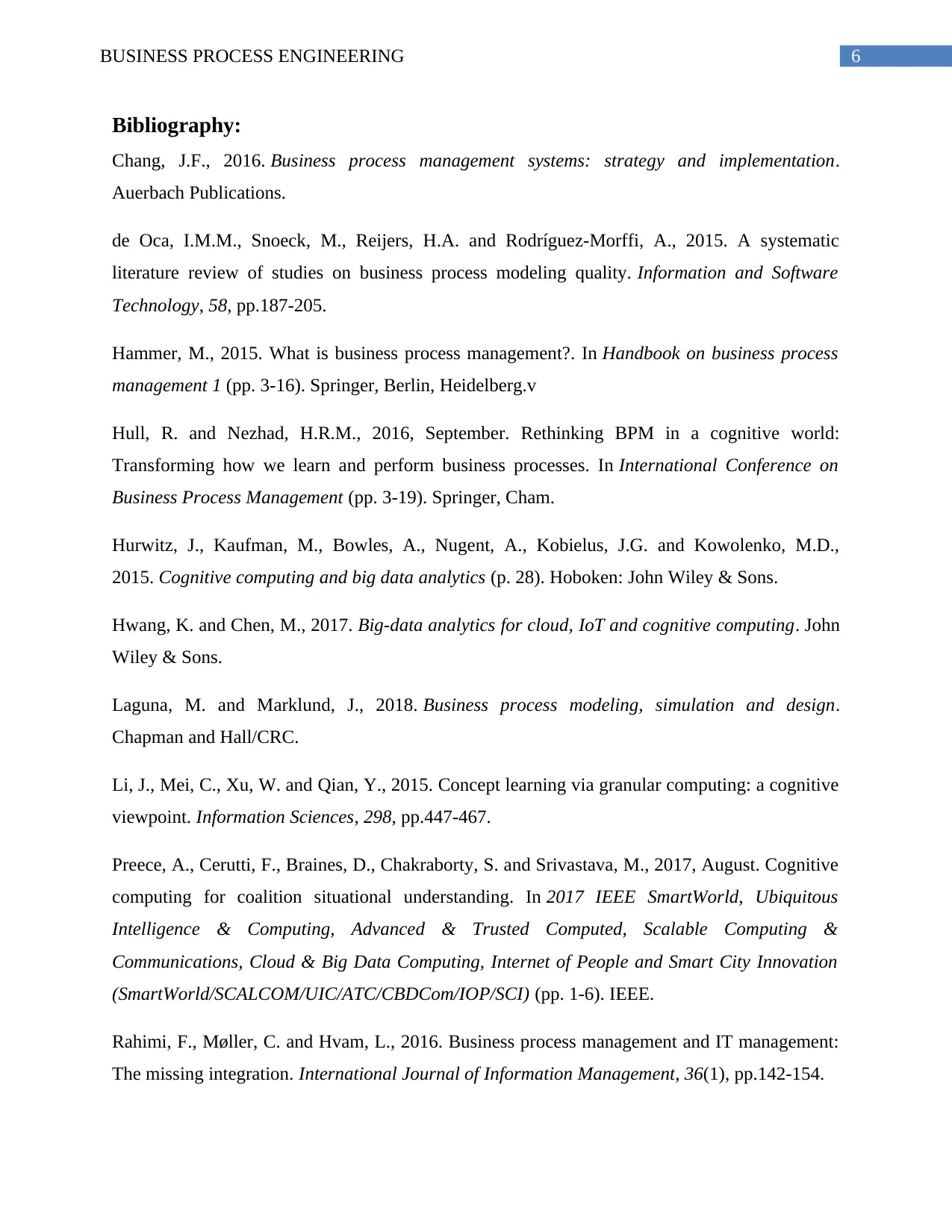
6BUSINESS PROCESS ENGINEERING
Bibliography:
Chang, J.F., 2016. Business process management systems: strategy and implementation.
Auerbach Publications.
de Oca, I.M.M., Snoeck, M., Reijers, H.A. and Rodríguez-Morffi, A., 2015. A systematic
literature review of studies on business process modeling quality. Information and Software
Technology, 58, pp.187-205.
Hammer, M., 2015. What is business process management?. In Handbook on business process
management 1 (pp. 3-16). Springer, Berlin, Heidelberg.v
Hull, R. and Nezhad, H.R.M., 2016, September. Rethinking BPM in a cognitive world:
Transforming how we learn and perform business processes. In International Conference on
Business Process Management (pp. 3-19). Springer, Cham.
Hurwitz, J., Kaufman, M., Bowles, A., Nugent, A., Kobielus, J.G. and Kowolenko, M.D.,
2015. Cognitive computing and big data analytics (p. 28). Hoboken: John Wiley & Sons.
Hwang, K. and Chen, M., 2017. Big-data analytics for cloud, IoT and cognitive computing. John
Wiley & Sons.
Laguna, M. and Marklund, J., 2018. Business process modeling, simulation and design.
Chapman and Hall/CRC.
Li, J., Mei, C., Xu, W. and Qian, Y., 2015. Concept learning via granular computing: a cognitive
viewpoint. Information Sciences, 298, pp.447-467.
Preece, A., Cerutti, F., Braines, D., Chakraborty, S. and Srivastava, M., 2017, August. Cognitive
computing for coalition situational understanding. In 2017 IEEE SmartWorld, Ubiquitous
Intelligence & Computing, Advanced & Trusted Computed, Scalable Computing &
Communications, Cloud & Big Data Computing, Internet of People and Smart City Innovation
(SmartWorld/SCALCOM/UIC/ATC/CBDCom/IOP/SCI) (pp. 1-6). IEEE.
Rahimi, F., Møller, C. and Hvam, L., 2016. Business process management and IT management:
The missing integration. International Journal of Information Management, 36(1), pp.142-154.
Bibliography:
Chang, J.F., 2016. Business process management systems: strategy and implementation.
Auerbach Publications.
de Oca, I.M.M., Snoeck, M., Reijers, H.A. and Rodríguez-Morffi, A., 2015. A systematic
literature review of studies on business process modeling quality. Information and Software
Technology, 58, pp.187-205.
Hammer, M., 2015. What is business process management?. In Handbook on business process
management 1 (pp. 3-16). Springer, Berlin, Heidelberg.v
Hull, R. and Nezhad, H.R.M., 2016, September. Rethinking BPM in a cognitive world:
Transforming how we learn and perform business processes. In International Conference on
Business Process Management (pp. 3-19). Springer, Cham.
Hurwitz, J., Kaufman, M., Bowles, A., Nugent, A., Kobielus, J.G. and Kowolenko, M.D.,
2015. Cognitive computing and big data analytics (p. 28). Hoboken: John Wiley & Sons.
Hwang, K. and Chen, M., 2017. Big-data analytics for cloud, IoT and cognitive computing. John
Wiley & Sons.
Laguna, M. and Marklund, J., 2018. Business process modeling, simulation and design.
Chapman and Hall/CRC.
Li, J., Mei, C., Xu, W. and Qian, Y., 2015. Concept learning via granular computing: a cognitive
viewpoint. Information Sciences, 298, pp.447-467.
Preece, A., Cerutti, F., Braines, D., Chakraborty, S. and Srivastava, M., 2017, August. Cognitive
computing for coalition situational understanding. In 2017 IEEE SmartWorld, Ubiquitous
Intelligence & Computing, Advanced & Trusted Computed, Scalable Computing &
Communications, Cloud & Big Data Computing, Internet of People and Smart City Innovation
(SmartWorld/SCALCOM/UIC/ATC/CBDCom/IOP/SCI) (pp. 1-6). IEEE.
Rahimi, F., Møller, C. and Hvam, L., 2016. Business process management and IT management:
The missing integration. International Journal of Information Management, 36(1), pp.142-154.
Paraphrase This Document
Need a fresh take? Get an instant paraphrase of this document with our AI Paraphraser
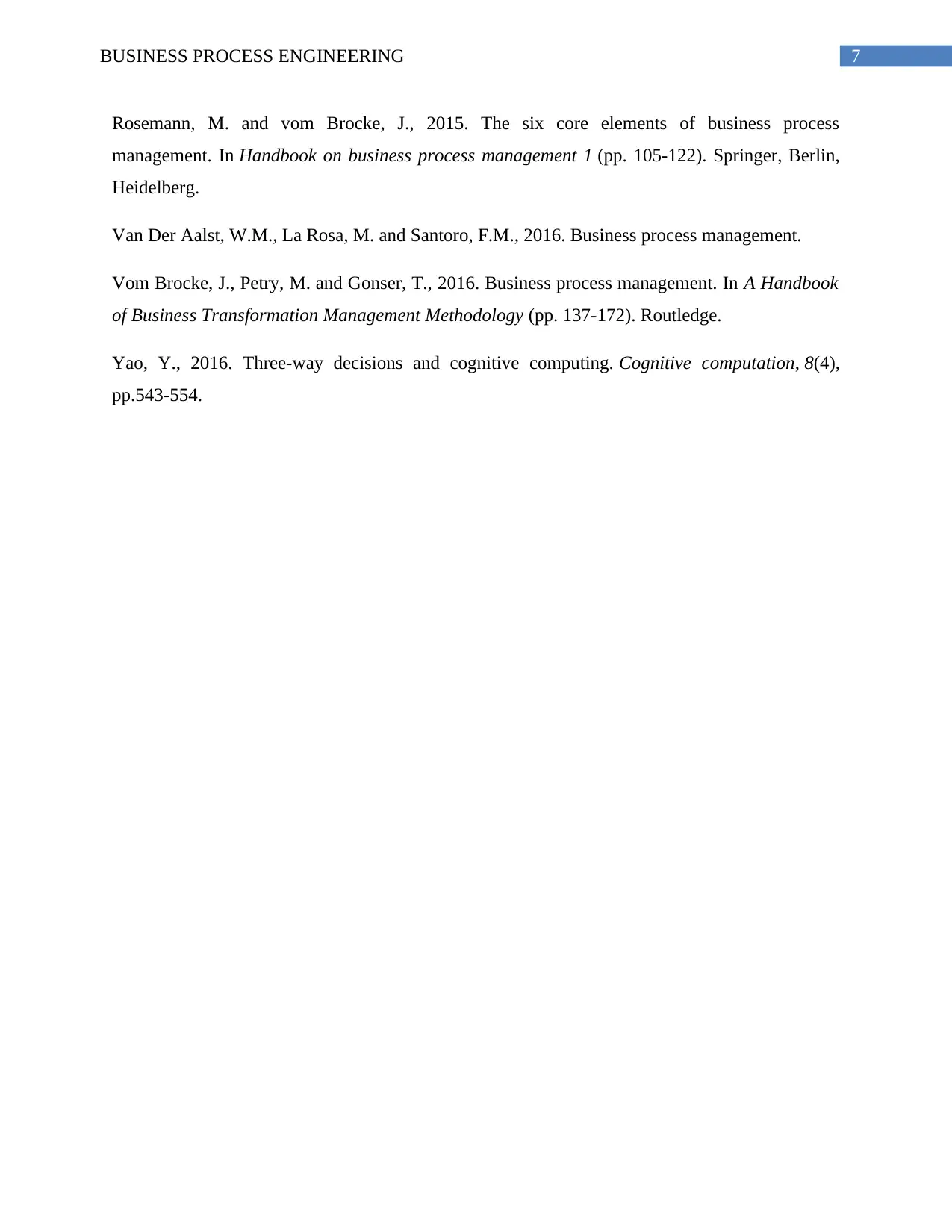
7BUSINESS PROCESS ENGINEERING
Rosemann, M. and vom Brocke, J., 2015. The six core elements of business process
management. In Handbook on business process management 1 (pp. 105-122). Springer, Berlin,
Heidelberg.
Van Der Aalst, W.M., La Rosa, M. and Santoro, F.M., 2016. Business process management.
Vom Brocke, J., Petry, M. and Gonser, T., 2016. Business process management. In A Handbook
of Business Transformation Management Methodology (pp. 137-172). Routledge.
Yao, Y., 2016. Three-way decisions and cognitive computing. Cognitive computation, 8(4),
pp.543-554.
Rosemann, M. and vom Brocke, J., 2015. The six core elements of business process
management. In Handbook on business process management 1 (pp. 105-122). Springer, Berlin,
Heidelberg.
Van Der Aalst, W.M., La Rosa, M. and Santoro, F.M., 2016. Business process management.
Vom Brocke, J., Petry, M. and Gonser, T., 2016. Business process management. In A Handbook
of Business Transformation Management Methodology (pp. 137-172). Routledge.
Yao, Y., 2016. Three-way decisions and cognitive computing. Cognitive computation, 8(4),
pp.543-554.
1 out of 8
Related Documents
Your All-in-One AI-Powered Toolkit for Academic Success.
+13062052269
info@desklib.com
Available 24*7 on WhatsApp / Email
![[object Object]](/_next/static/media/star-bottom.7253800d.svg)
Unlock your academic potential
Copyright © 2020–2025 A2Z Services. All Rights Reserved. Developed and managed by ZUCOL.





